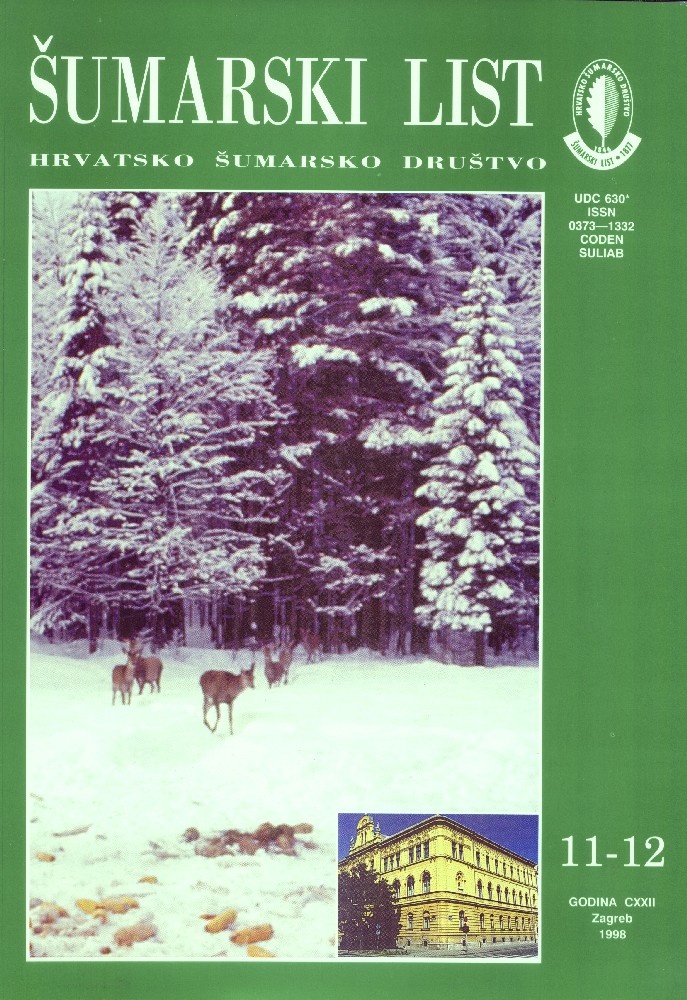
broj: 11-12/1998
pdf (21,9 MB) |
|
||||||||||||||
| IZVORNI ZNANSTVENI ČLANCI | ||
| Roša, J. | UDK 630* 165 + 168 + 48 (Quercus robur) 001. | |
| The Influence of Phosphogypsum From an Industrial Dump on the Pedunculate Oak (Quercus robur) pdf HR EN | 491 | |
| PRETHODNO PRIOPĆENJE | ||
| Domac, J. | UDK 630* 238 : 620. 91 | |
| Present and Future Energy Production from Forestry Biomass pdf HR EN | 507 | |
| Summary: Although significant biomass potential, biomass had never taken an important place in the energetic policy of the Republic of Croatia in the past. However, Croatian foresters, both scientists and engineers have done many researching and developed different technologies for energy production from biomass. Historically biomass has been used by the rural population in a large scale for heating and cooking in all Croatian regions. Heating wood and commercial and non-commercial cutting down woods amounted to 15 per cent of primary energy consumption in 1970, and in 1990 that part, due to urbanisation and growth of living standards was 5,3 per cent. Today, bioenergy contributes only with 4,6 per cent in total energy supply and fuelwood and wood waste from wood industry are the most important biomass resources.Today, biomass energy is experiencing a surge in interest in many parts of the world due to: greater recognition of its current role and future potential contribution as a modern fuel in the world´s energy supply; its availability, versatility, and sustainability; a better understanding of its global and local environmental benefits; perceived potential role in climate stabilisation; the existing and potential development; technological advances and knowledge which have recently accumulated on many aspects of biomass energy. Recently launched, national energy program BIOEN (Biomass and Waste Use Program) has the aim of providing permanent care for the use of biomass and waste for energy production and environment protection. The Program has a long - term character and will be based on the positive experiences of inland experts and of those European Union countries that have realised similar programs with success. This program plans to use wood waste, straw, agricultural crops, crop residues, animal waste, municipal waste and other primary biomass sources as well as processed biomass like liquid (biodiesel, ethanol, methanol) and gaseous (biogas, methane) fuels for energy production, traffic purposes or as a base in chemical industry. The Energy Strategy of the Republic of Croatia has considered three different scenarios. First of them (SI, "low ") was based on slow introduction of advanced technologies and does not include any governmental support. Second scenario (S2, "moderate") includes stronger concerted policy for introduction of new technologies, use of renewables and increasing energy efficiency. Finally, third scenario (S3, "high") is "very environmental" scenario and comprises that problem with pollution and greenhouse effects will significantly affect energy policy in Croatia already in 2010. All scenarios have the same rate of economical growth, economy structure and number of consumers, but not the same consumption rate. The main differences are in level of governmental support, which influence the use of renewables, dynamics of advanced technologies penetration and care for energy efficiency. Unlike other renewables, bioenergy has significant position in all scenarios. This is due to long tradition and experience of biomass use in Croatia as well as large biomass potential. The principal parameters of the scenarios related to biomass use are: current and additional biomass resources, potential user sectors, assessment of the energy demand, and assumption on the type of energies per sector abandoned in favour of bioenergy. The scenarios differ most significantly in the structure of different technologies for biomass utilisation, in the electricity generation from biomass and in the penetration of biofuels in transport. This paper deals with present and future energy production from forestry biomass (fuel wood, forestry residues and wood waste). Forestry biomass is recognised as most important source of bioenergy and has significant place in all analysed scenarios. Key words: energy production; energy scenario; forestry biomass | ||
| PREGLEDNI ČLANCI | ||
| Grubešić, M., Krapinec, K. | UDK 630* 151 + 152 | |
| Colonization of the Beaver (Castor fiber L. in the Sava Valley pdf HR EN | 515 | |
| STRUČNI ČLANCI | ||
| Zelić, J. | UDK 630* 181.1 + 182.1 + 22 | |
| Autochthonism and Further Cultivation of Sweet Chestnut (Castanea sativa Mill.) in Požega Mountains pdf HR EN | 525 | |
| Đuričić, I., Đuričić-Kuric, T. | UDK 630* 907.1 : 719 + 72.02 | |
| Wineyard Cottages on Southern Slopes of Mount Kalnik pdf HR EN | 537 | |


